This article is sponsored by Zyxel.
Oh, how the times are a-changin’. Today we have more connected devices in our homes than ever before. Products like surveillance cameras, smart thermostats, entertainment systems and smart speakers add more traffic than the traditional home network had in the past. All those tablets, laptops and smartphones that have somehow crept into your home have also increased the need for higher bandwidth, better coverage and increased capacity.
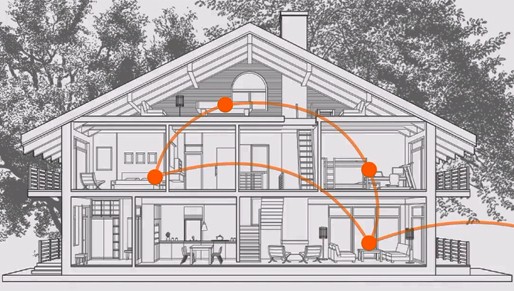
If you’re reading this, you’re either considering moving up to a multi-node Wi-Fi System, aka "mesh" Wi-Fi, or have already pulled the trigger. But to get your new baby working at peak performance, there are a few things you should know.
It’s All About The Backhaul
Conventional Wi-Fi systems are made up of multiple access points (APs). Each AP connects Wi-Fi devices to a wired (Ethernet) network. This AP-to-AP connection is called the backhaul and it forms the backbone of any wireless network.
Most homes, however, don’t have Ethernet running to all the places where you may want to place an AP. So Wi-Fi systems use specialized APs (mesh nodes) that use Wi-Fi for the backhaul instead of Ethernet. Data is passed wirelessly from node to node until it reaches the one node connected to your modem (the "root" node). So it’s important that the wireless backhaul has enough bandwidth to handle the volume of data traffic, or it becomes a choke point.
Lower cost Wi-Fi Systems usually have two radios per mesh node, one for each of the two Wi-Fi bands (2.4 GHz and 5 GHz). These radios must connect to Wi-Fi devices, then also pass that data from mesh node to mesh node until it reaches the root node. So this means each radio is doing twice the work to move each piece of data, reducing the amount of data that can be handled (the bandwidth) by about half.
"Tri-band" Systems add a second 5 GHz radio, which can be dedicated to handling backhaul data. This avoids the retransmission penalty of two-radio systems, but can run into trouble when that single backhaul channel has to handle all the data from four or more radios.
The diagrams below compare backhaul bandwidth requirements for a three node Wi-Fi system. Only four fronthaul (client device connection) radios are shown because the third pair of radios sits in the root node, which has the Ethernet connection and doesn’t use Wi-Fi backhaul.
The diagram proportionately sizes the bars for maximum bandwidth for each connection type; 300 Mbps for 2.4 GHz and 867 Mbps for 5 GHz. These are the highest bandwidths that two-stream connections can support.
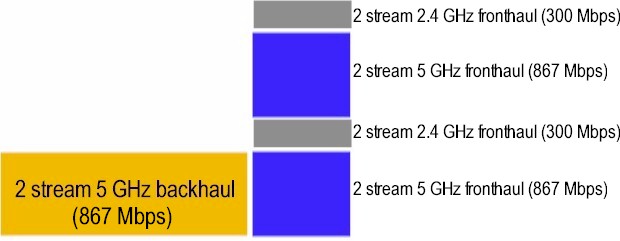
Two-stream dedicated backhaul
The diagram above shows that even with a dedicated 5 GHz backhaul, the combined output of four fronthaul (client device connecting) radios can easily overwhelm it. Heck, if even one of the 5 GHz fronthaul radios is fully loaded, the backhaul will be maxed out.
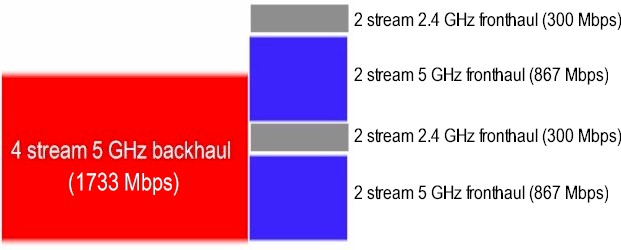
Best-in-class Wi-Fi Systems, like Zyxel’s Multy X, use a dedicated four-stream backhaul radio. The second diagram above shows the higher bandwidth provided by the four-stream radio can handle the bandwidth requirements of two or even three of the fronthaul radios. More backhaul bandwidth means more clients can get as much bandwidth as they need. More bandwidth = happy family!
Zyxel Multy X four-stream dedicated backhaul
Location, Location, Location
Knowing where to place a Wi-Fi system node isn’t an exact science, and we all can use a little help. Bad placement impacts performance not just for your wireless devices, but for backhaul as well.
If nodes are placed too far apart, backhaul bandwidth will be reduced along with client performance. If they are placed too closely together, devices may not smoothly switch (roam) from node to node due to too much overlap between mesh nodes. Too-close placement also means coverage may suffer because APs are not getting close enough to the areas they need to cover.
Home construction materials also matter. Brick or block walls, metal framing studs and even a home’s age can reduce signals. Turn-of the century Victorians can hide chicken-wire or other forms of metal mesh used to reinforce old plaster walls.
Furnishings can also make a difference. While it may be tempting to hide a mesh node away in an entertainment center cabinet, or behind your huge flatscreen TV, wood and metal are not your mesh node’s friends. Also keep an eye out for mirrors, aquariums, refrigerators and other large appliances that will block or greatly reduce Wi-Fi signals.
With all these challenges, you should get some help from your Wi-Fi System. Multy X’s Android and iOS apps make sure you get node placement right, with an easy to understand location screen.
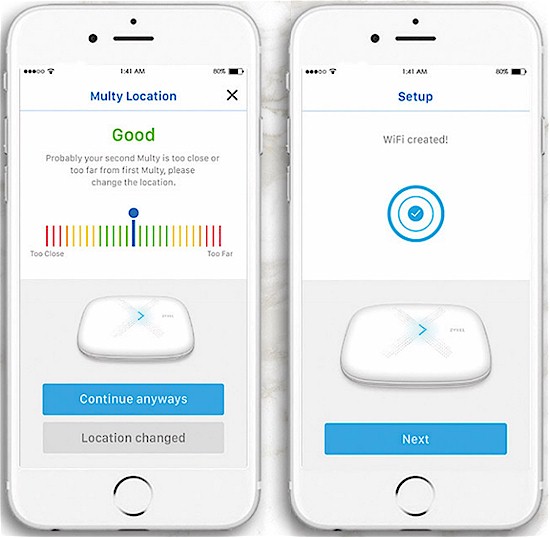
Multy X’s app helps optimize node placement
Use The App, Luke
The Force may help Jedis, but it won’t help you set up a brand-new Wi-Fi system. Smartphone apps and Bluetooth connections together provide simpler and easier Wi-Fi System setup and management.
Bluetooth connection eliminates the need to know which SSID to use or what WPA key to enter, making it easy for anyone to set up a Wi-Fi system. It also removes the requirement to be connected to Wi-Fi when setting up a network. Some smartphones will aggressively connect to a cellular signal if their usual Wi-Fi network disappears–just as it would during installing a new Wi-Fi System! With Bluetooth-based setup, problem avoided.
Once you’re in the app, you want to stay there. Your Wi-Fi System shouldn’t require you to use the app for some things, but launch a web browser and access a different interface to manage other features. Zyxel’s Multy X app handles it all, from installation to managing Parental Controls…and more.

Wi-Fi Systems use app-based management
Prepare For Smooth Roaming
With multiple APs, devices often need to move their Wi-Fi connection when their physical location changes. Because Wi-Fi Systems use the same network name (SSID) for all mesh nodes, device connection management is even more important.
Newer devices that support roaming assist IEEE standards 802.11k, v and r need a Wi-Fi system that also supports them. Older devices can benefit from some roaming assistance, too.
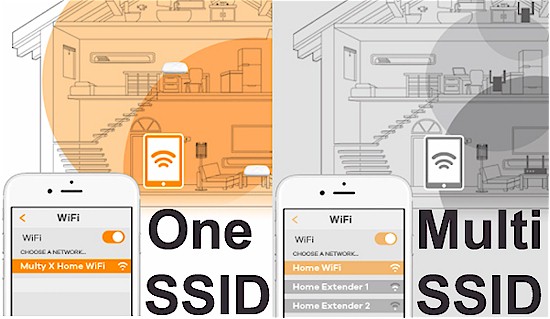
Wi-Fi Systems use a single SSID
Multy X supports the 802.11k and v standards to assist roaming for devices that also support these standards. It also uses band steering and RSSI (signal level) based roam assistance to help move all devices to the best mesh node for them.
Wi-Fi By Voice
Since Amazon’s Alexa can control lights, thermostats and what you watch on TV, why not let it ease your Wi-Fi management chores? Multy X supports Amazon Alexa skills to turn guest Wi-Fi on and off, test internet speed and pause internet access. As long as Alexa can hear you, you can leave your smartphone in your pocket for these common tasks.
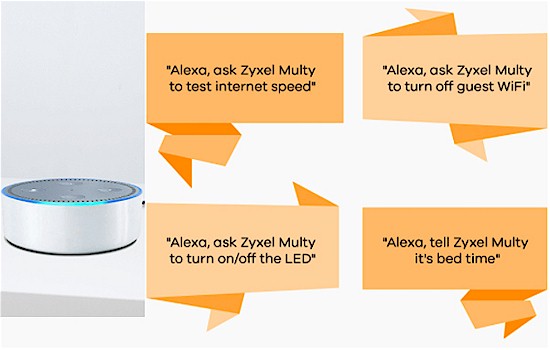
Amazon Alexa makes managing Multy X easy
So now that you know the secrets of a great Wi-Fi system–high-bandwidth backhaul, intelligent installation assistance, single-point management, multi-level roaming assistance and voice-enabled control–why not get a system that knows them, too? Learn more about Zyxel’s Multy X AC3000 Tri-Band WiFi System right now!

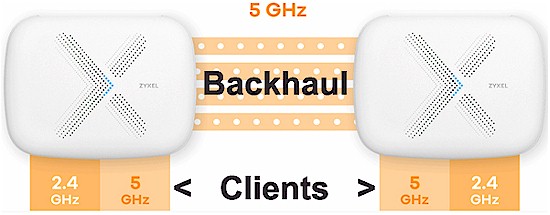
 Read more about Zyxel.
Read more about Zyxel.